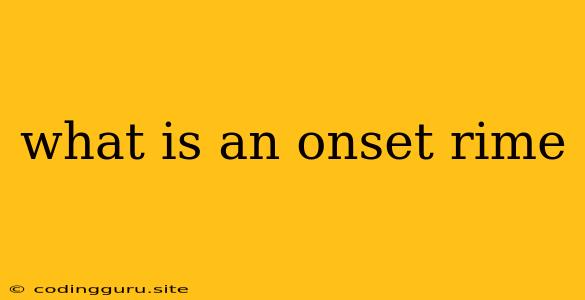What is an Onset Rime?
Have you ever noticed how words like "cat," "hat," and "bat" sound similar? This is because they share the same ending sound, which is called a rime. But what about the beginning sounds, like "c," "h," and "b"? These are called onsets.
In simple terms, onset is the beginning sound of a word, and rime is the ending sound of a word. Together, they form the whole word.
Understanding Onset Rime: A Fun Analogy
Imagine building a house. The foundation of the house is like the rime, it's the core structure that everything else rests on. The walls are like the onset, they add to the foundation and make the house complete. Just like the foundation and walls make a house, the onset and rime make a word!
Why is Onset Rime Important?
Understanding onset rime can be very helpful for learning to read and write. Here's why:
- Word Recognition: By recognizing the rime in a word, a child can easily guess other words that share the same rime, like "cat," "hat," and "bat." This makes reading faster and easier.
- Spelling: Knowing onset rime helps children spell words correctly. For example, if a child knows the rime "at," they can easily spell "cat," "hat," and "bat."
- Phonological Awareness: Working with onset rime helps children develop their phonological awareness, which is the ability to hear and manipulate the sounds in language. This is a crucial skill for learning to read and write.
How Can You Use Onset Rime?
There are many fun and engaging ways to help children learn about onset rime:
- Rhyming Games: Play games like "I Spy" or "Rhyme Time" where children have to find words that rhyme.
- Word Sorting: Create a simple activity where children sort words into groups based on their rime (e.g., "cat," "hat," "mat" vs. "dog," "frog," "log").
- Storytelling: Create a story with words that have the same rime. For example, "The cat sat on the mat, then the fat rat ate the cheese!"
Example Activities for Onset Rime
Here are some simple examples of onset rime activities:
1. Rime Match:
- Create cards with pictures or words that have the same rime, for example: "cat," "hat," "bat."
- Have children match the cards that have the same rime.
2. Onset Sound Hunt:
- Say a word like "ball."
- Ask children to find objects in the room that start with the same sound as "ball" (e.g., "book," "balloon").
Conclusion
Understanding onset rime is an essential building block for early literacy skills. By engaging children with fun activities and games that focus on onset rime, you can help them develop strong reading and spelling skills. Remember, just like a house needs a foundation and walls, a word needs an onset and rime to be complete!
